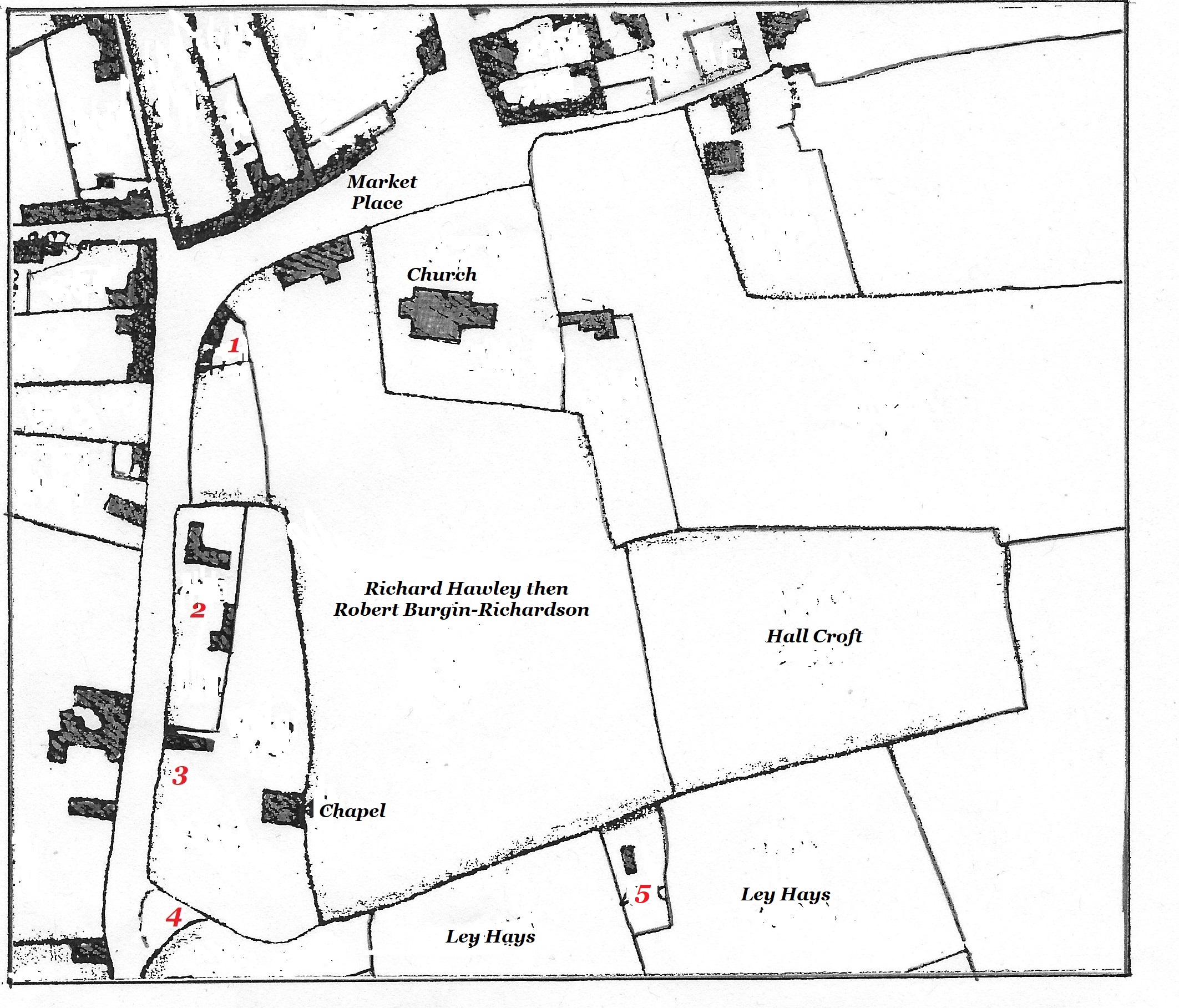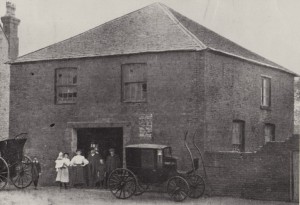When was it built ?
Adeline writes that “the old Cricket Ground Chapel was the home of the Old Wesleyans. It was built in 1786.” … a chapel with which Adeline was most familiar. Her date of 1786 is of course the year that John Wesley travelled the ‘miserable roads’ on his visit to Ilkeston.
After this visit to the town a Wesley mission was formed and met in members’ homes, and by 1795 a Meeting House or Chapel had been established in Burgin Yard. This Yard was on the opposite side of South Street to Queen’s Terrace– as you entered the Yard from South Street — at what is now the junction of that street and Coronation Street – the chapel was at the far right end of the Yard. It was approximately on the site of the Ritz Bingo Hall car park.
In his Pioneer articles, Waterhouse states that the chapel was built on land, previously part of the ‘Burgin premises’ and owned by bachelor wheelwright John Burgin-Richardson. He was the oldest surviving son of farmer and blacksmith Robert and Sarah (nee Henshaw) and the grandson of Thomas Richardson and his wife Elizabeth (nee Burgin). In 1786 John sold 120 square yards of his Burgin’s croft to the builders of the chapel, thus supporting Adeline’s date of founding.
There is further evidence to support this date among the papers of Ilkeston brickmaker/builder of Elijah Brentnall of the Anchor Inn. Elijah’s grandfather was William Brentnall (c.1753-1830) who is mentioned in these papers: — “This meeting house was begun to be builded the 14 of August 1786, by Edward Wetelocks (Whitelocks ?) and John Beate in pardonship together, of Watnal: and Will Brentnall was brick lears as did the building. In 10 days and a piece they laid 43 thousand and some od bricks. All most half the bricks was ould ones came out of Ilkeston ould engine at 8s a thousand, and the new bricks was sould at 13 and 6 per thousand. The outside took four waging load of lime from Bullwell lime killn, and about 1 quarter over.
P.S. — This chappel walls is 14 inch work”
Where was it built ?
The map below, of the Market Place area about 1800, shows the position of the chapel in a parcel of land owned by John Burgin-Richardson. (By 1800 John had died and the property had passed to his brother James. It is also discussed elsewhere).
Who were its founders ?
Waterhouse continues his article …….
“It may interest Methodists to know the founders of this chapel; they were Samuel James*, Micah Willcox**, John Lees and William Jackson, all of Ilkeston. By April 1787 the chapel was built and Richard Birch and Samuel Cowley of Ilkeston, Thomas Salt and Henry Taft of Stanton-by-Dale were added to the trustees”.
This was Adeline’s ‘Cricket Ground Chapel’, a name which it probably acquired several years after it was built — the actual Cricket Ground dates from many years after the building date for the chapel.
*Samuel James was a mercer (a textile trader) and the father of Ann Dorothy James and Thomas Roe James (See On the east side). He was also one-time owner of the King’s Head — the one at the southern corner of East Street and not the Market Place inn of the same name.
**Micah Willcox was one-time keeper of the White Lion Inn.
At the time that the new Bath Street Wesleyan Chapel was opened in March 1898 the local press referred to the year 1786 as the year in which the Cricket Ground chapel had been built — obviously the generally-accepted year of its construction, although 1794 is often quoted.
Bagshaw’s Directory of 1846 states that “in 1838 his grace the Duke of Rutland had given two and a half acres of land for a cricket ground (to the south of St. Mary’s Church) and half an acre of land in front of the church to enlarge the market place. From the latter an old farm house and cottage were taken down, and the refuse soil taken to level the Cricket Ground, which is allowed to be equal to any in the kingdom”.
This Cricket Ground Chapel was the first Methodist Chapel erected in Ilkeston. A story passed down through time was that the women of the chapel, ‘in their zeal consented to carry the bricks for building it; and the principla beams, which were 0oak, were cut out of Cotmanhay Wood, and given by the wood steward to the Duke of Rutland’. (IP Oct 16th 1896)
The Cricket Ground Chapel. Photograph taken in the 1900’s. (courtesy of Ilkeston Reference Library).
“The Cricket Ground Chapel was a place of worship until 1859 or thereabouts, and was the South Street Sunday School until 1867” recalls Adeline. The chapel later served as a livery stable and in 1898 was used as a joiner’s workshop. It was demolished about 1920.
———————————————————————————————————————————————-
Bagshaw’s Directory description dates from a couple of years after that of the publication of the first of the Fly Leaves.



